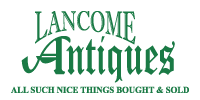
Bits & Bites on Antiques
...Did You Know?
Five quick ways to decrease the value of your antiques:
-
Improper cleaning. Removing the patina can greatly diminish their value.
-
Refinishing furniture. The “less is more” rule should apply here. Try and keep the original finish whenever possible. A gentle cleaning may suffice.
-
Displaying in Sunlight. Antiques such as photographs and textiles can be damaged from direct sunlight.
-
Amateur restoration. Leave the more complicated restorations projects for professionals.
-
Improper storage. Keep your family heirlooms out of damp basements and hot attics.
Refinishing liquids (linseed oil, lacquer thinners, etc) are highly volatile solutions and should only be used in well ventilated areas preferably outside. Never use near an open flame. Also remember to properly dispose of any used rags (they are combustible). If I want to reuse a rag I temporarily store them in a sealed steel can (with lid so the air can’t get at them).
Coins should never be cleaned because it makes them less desirable to collectors. Brush off any dirt, dust etc., otherwise they should be left in an "as found" condition.
Ceramics can be washed with soap and water, but only wipe gently with a damp cloth if the item has been repaired, damaged, or has cold-painted decorations. If you don’t know an item has repairs I use a “black” light shone over the item. In most cases you will see the repair.
To remove unpleasant smells from an old chest of drawers, I use baking soda, cat litter, or charcoal chips to absorb the odor. You probably should do this in the garage or basement. I did this once in the kitchen and got yelled at because the kitchen started to smell like an open sewer.
Lemon juice is a great way to remove the remains of gum, adhesive tape, and other sticky tapes and it’s all natural and easy on the environment unlike solvents, etc.
Clean mildew on wooden furniture with a cloth moistened with one cup water mixed with one tablespoon bleach and one tablespoon liquid dishwashing detergent. Dry with a clean cloth.
It’s not a good idea to use plastic or plastic bubble wrap to store silver and ceramics. Heat and humidity can cause permanent discolorations.
Never polish dark antique bronze. You will destroy the old patina and lower the value of the piece. When in doubt I always abide by the rule “leave it alone”
I have had a lot of success with this formula for cleaning and rehydrating dry wood on furniture. I received it from a very dear friend of mine:
-
Half a pint boiled linseed oil
-
Half a pint cider vinegar
-
Half a pint turpentine
-
1 tsp denatured alcohol (methyl hydrate)
Mix ingredients above and SHAKE WELL! Using fine steel wool (0000) or a terry cloth rub off dirt then wipe with a clean terry cloth.
Refinishing Formula
I received this formula from an elderly teacher when I signed up a few years ago for an upholstery course. It is very effective when stripping clock cases, furniture, etc. of old varnish and lacquer (not effective on painted surfaces). Mix equal parts of denatured alcohol (methyl hydrate) and lacquer thinner in a container. Mix well. Apply to the surface with a paint brush and the finish should run off quite easily. Rinse with cold water and dry the piece.



